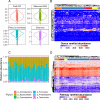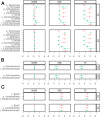Analysis of correlations between gut microbiota, stool short chain fatty acids, calprotectin and cardiometabolic risk factors in postmenopausal women with obesity: a cross-sectional study
- PMID: 36503483
- PMCID: PMC9743526
- DOI: 10.1186/s12967-022-03801-0
Analysis of correlations between gut microbiota, stool short chain fatty acids, calprotectin and cardiometabolic risk factors in postmenopausal women with obesity: a cross-sectional study
Abstract
Background: Microbiota and its metabolites are known to regulate host metabolism. In cross-sectional study conducted in postmenopausal women we aimed to assess whether the microbiota, its metabolites and gut barrier integrity marker are correlated with cardiometabolic risk factors and if microbiota is different between obese and non-obese subjects.
Methods: We analysed the faecal microbiota of 56 obese, postmenopausal women by means of 16S rRNA analysis. Stool short chain fatty acids, calprotectin and anthropometric, physiological and biochemical parameters were correlates to microbiome analyses.
Results: Alpha-diversity was inversely correlated with lipopolysaccharide (Rho = - 0.43, FDR P (Q) = 0.004). Bray-Curtis distance based RDA revealed that visceral fat and waist circumference had a significant impact on metabolic potential (P = 0.003). Plasma glucose was positively correlated with the Coriobacteriaceae (Rho = 0.48, Q = 0.004) and its higher taxonomic ranks, up to phylum (Actinobacteria, Rho = 0.46, Q = 0.004). At the metabolic level, the strongest correlation was observed for the visceral fat (Q < 0.15), especially with the DENOVOPURINE2-PWY, PWY-841 and PWY0-162 pathways. Bacterial abundance was correlated with SCFAs, thus some microbiota-glucose relationships may be mediated by propionate, as indicated by the significant average causal mediation effect (ACME): Lachnospiraceae (ACME 1.25, 95%CI (0.10, 2.97), Firmicutes (ACME 1.28, 95%CI (0.23, 3.83)) and Tenericutes (ACME - 0.39, 95%CI (- 0.87, - 0.03)). There were significant differences in the distribution of phyla between this study and Qiita database (P < 0.0001).
Conclusions: Microbiota composition and metabolic potential are associated with some CMRF and fecal SCFAs concentration in obese postmenopausal women. There is no unequivocal relationship between fecal SCFAs and the marker of intestinal barrier integrity and CMRF. Further studies with appropriately matched control groups are warranted to look for causality between SCFAs and CMRF.
Keywords: Cardiometabolic risk; Menopause; Metabolism; Microbiota; Obesity; SCFA.
© 2022. The Author(s).
Conflict of interest statement
Mariusz Kaczmarczyk and Karolina Skonieczna-Żydecka receive remuneration from probiotic company. Igor Łoniewski is the probiotic company CEO. Other authors report no conflicts of interest.
Figures




Similar articles
-
Distal colonic transit is linked to gut microbiota diversity and microbial fermentation in humans with slow colonic transit.Am J Physiol Gastrointest Liver Physiol. 2020 Feb 1;318(2):G361-G369. doi: 10.1152/ajpgi.00283.2019. Epub 2019 Dec 23. Am J Physiol Gastrointest Liver Physiol. 2020. PMID: 31869241
-
Gut microbiota and short chain fatty acids partially mediate the beneficial effects of inulin on metabolic disorders in obese ob/ob mice.J Food Biochem. 2022 May;46(5):e14063. doi: 10.1111/jfbc.14063. Epub 2022 Feb 7. J Food Biochem. 2022. PMID: 35128673
-
Higher Fecal Short-Chain Fatty Acid Levels Are Associated with Gut Microbiome Dysbiosis, Obesity, Hypertension and Cardiometabolic Disease Risk Factors.Nutrients. 2018 Dec 27;11(1):51. doi: 10.3390/nu11010051. Nutrients. 2018. PMID: 30591685 Free PMC article.
-
Short-Chain Fatty Acids-A Product of the Microbiome and Its Participation in Two-Way Communication on the Microbiome-Host Mammal Line.Curr Obes Rep. 2023 Jun;12(2):108-126. doi: 10.1007/s13679-023-00503-6. Epub 2023 May 19. Curr Obes Rep. 2023. PMID: 37208544 Free PMC article. Review.
-
The role of short-chain fatty acids in the interplay between gut microbiota and diet in cardio-metabolic health.Gut Microbes. 2021 Jan-Dec;13(1):1-24. doi: 10.1080/19490976.2021.1897212. Gut Microbes. 2021. PMID: 33764858 Free PMC article. Review.
Cited by
-
Gut microbiota and microbial metabolites are associated with body composition in 5-year-old children: A cross-sectional study in the Gen3G cohort.Pediatr Obes. 2025 Jun;20(6):e70007. doi: 10.1111/ijpo.70007. Epub 2025 Mar 10. Pediatr Obes. 2025. PMID: 40059505
-
The Potential Role of SCFAs in Modulating Cardiometabolic Risk by Interacting with Adiposity Parameters and Diet.Nutrients. 2024 Jan 16;16(2):266. doi: 10.3390/nu16020266. Nutrients. 2024. PMID: 38257159 Free PMC article.
-
Tryptophan metabolism as bridge between gut microbiota and brain in chronic social defeat stress-induced depression mice.Front Cell Infect Microbiol. 2023 Feb 24;13:1121445. doi: 10.3389/fcimb.2023.1121445. eCollection 2023. Front Cell Infect Microbiol. 2023. PMID: 36909723 Free PMC article.
-
Eight-Hour Time-Restricted Feeding: A Strong Candidate Diet Protocol for First-Line Therapy in Polycystic Ovary Syndrome.Nutrients. 2023 May 10;15(10):2260. doi: 10.3390/nu15102260. Nutrients. 2023. PMID: 37242145 Free PMC article.
References
MeSH terms
Substances
LinkOut - more resources
Full Text Sources

